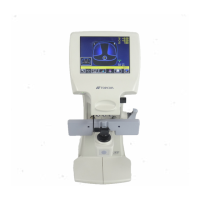− 13 −
R-CL300-0-1204-02
2-4 Measurement Principle
CL-300 has employed the imaging system different from that in CL-2500 or the manual lens meter LM. It
enables the non-imaging system by using the two-dimensional CCD.
The measurement principle is described based on the following optical arrangement sketch drawing.
The light emitted from the LED is changed into the spot light using the ball lens and then, it is changed into
parallel rays using the collimator lens. These rays are sent into the lens to be tested.
After going through the lens to be tested, the light is changed into 8-spot images using the target with the
eight circular openings and is projected on the surface of the two-dimensional CCD.
In the case that the lens to be tested has not been inserted (Fig 1), the light as parallel rays goes through the
openings on the target, and so the interval between the openings on the target is approximately equal to that
between the images created on the CCD. At that time, the positions of the images created on the CCD are
used as the reference positions.
On the contrary, when the lens to be tested with positive power, is inserted (Fig. 2), the interval between the
images on the CCD is smaller than that of the openings on the target.
In the case that the lens with cylindricality is inserted, the interval between the eight point images created on
the CCD is changed. This direction is regarded as the axial angle.
The light emitted from the UVLED is changed into the spot light using the ball lens and then, it is changed
into parallel rays using the collimator lens. These rays are sent into the lens to be tested.
After going through the lens to be tested, the light is projected on the two-dimensional CCD and is converted
into electricity. The light accumulated in the given time is calculated as the integral time.
The status without lens is regarded as “100%”. By comparing with the status with lens, transmittance is
calculated.
Diaphragm
Collimator Lens
Target
LED
Ball Lens
Lens to be tested
Two-dimensional CCD
Target
Opening
UVLED

